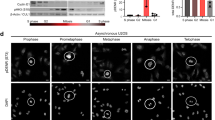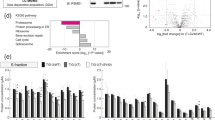Abstract
The transcription factor c-Myc has a critical role in cell proliferation and growth. The control of ribosome biogenesis by c-Myc through the regulation of transcription mediated by all three RNA polymerases is essential for c-Myc-driven proliferation. Specifically, in the nucleolus, c-Myc has been shown to be recruited to ribosomal DNA and activate RNA polymerase (pol) I-mediated transcription of ribosomal RNA (rRNA) genes. In addition, c-Myc accumulates in nucleoli upon inhibition of the proteasome, suggesting nucleolar localization also has a role in c-Myc proteolysis. Nucleophosmin (NPM), a predominantly nucleolar protein, is also critical in ribosome biogenesis and, like c-Myc, is found overexpressed in many types of tumors. Previously, we demonstrated that NPM directly interacts with c-Myc and controls c-Myc-induced hyperproliferation and transformation. Here, we show that NPM is necessary for the localization of c-Myc protein to nucleoli, whereas c-Myc nucleolar localization is independent of p53, Mdm2 and ARF. Conversely, high transient NPM expression enhances c-Myc nucleolar localization, leading to increased c-Myc proteolysis. In addition, NPM is necessary for the ability of c-Myc to induce rRNA synthesis in the nucleolus, and constitutive NPM overexpression stimulates c-Myc-mediated rRNA synthesis. Taken together, these results demonstrate an essential role for NPM in c-Myc nucleolar localization and c-Myc-mediated rDNA transcription.
This is a preview of subscription content, access via your institution
Access options
Subscribe to this journal
Receive 50 print issues and online access
$259.00 per year
only $5.18 per issue
Buy this article
- Purchase on Springer Link
- Instant access to full article PDF
Prices may be subject to local taxes which are calculated during checkout




Similar content being viewed by others
References
Meyer N, Penn LZ . Reflecting on 25 years with MYC. Nat Rev Cancer 2008; 8: 976–990.
Albihn A, Johnsen JI, Henriksson MA . MYC in oncogenesis and as a target for cancer therapies. Adv Cancer Res 2010; 107: 163–224.
Montanaro L, Trere D, Derenzini M . Nucleolus, ribosomes, and cancer. Am J Pathol. 2008; 173: 301–310.
Sirri V, Urcuqui-Inchima S, Roussel P, Hernandez-Verdun D . Nucleolus: the fascinating nuclear body. Histochem Cell Biol 2008; 129: 13–31.
Dai MS, Lu H . Crosstalk between c-Myc and ribosome in ribosomal biogenesis and cancer. J Cell Biochem 2008; 105: 670–677.
Arabi A, Wu S, Ridderstrale K, Bierhoff H, Shiue C, Fatyol K et al. c-Myc associates with ribosomal DNA and activates RNA polymerase I transcription. Nat Cell Biol 2005; 7: 303–310.
Grandori C, Gomez-Roman N, Felton-Edkins ZA, Ngouenet C, Galloway DA, Eisenman RN et al. c-Myc binds to human ribosomal DNA and stimulates transcription of rRNA genes by RNA polymerase I. Nat Cell Biol 2005; 7: 311–318.
Grewal SS, Li L, Orian A, Eisenman RN, Edgar BA . Myc-dependent regulation of ribosomal RNA synthesis during Drosophila development. Nat Cell Biol 2005; 7: 295–302.
Poortinga G, Wall M, Sanij E, Siwicki K, Ellul J, Brown D et al. c-MYC coordinately regulates ribosomal gene chromatin remodeling and Pol I availability during granulocyte differentiation. Nucleic Acids Res 2011; 39: 3267–3281.
Shiue CN, Berkson RG, Wright AP . c-Myc induces changes in higher order rDNA structure on stimulation of quiescent cells. Oncogene 2009; 28: 1833–1842.
Sanders JA, Gruppuso PA . Nucleolar localization of hepatic c-Myc: a potential mechanism for c-Myc regulation. Biochem Biophys Acta 2005; 1743: 141–150.
Arabi A, Rustum C, Hallberg E, Wright AP . Accumulation of c-Myc and proteasomes at the nucleoli of cells containing elevated c-Myc protein levels. J Cell Sci 2003; 116 (Pt 9): 1707–1717.
Welcker M, Orian A, Grim JE, Eisenman RN, Clurman BE . A nucleolar isoform of the Fbw7 ubiquitin ligase regulates c-Myc and cell size. Curr Biol 2004; 14: 1852–1857.
Yada M, Hatakeyama S, Kamura T, Nishiyama M, Tsunematsu R, Imaki H et al. Phosphorylation-dependent degradation of c-Myc is mediated by the F-box protein Fbw7. Embo J 2004; 23: 2116–2125.
Welcker M, Orian A, Jin J, Grim JE, Harper JW, Eisenman RN et al. The Fbw7 tumor suppressor regulates glycogen synthase kinase 3 phosphorylation-dependent c-Myc protein degradation. Proc Natl Acad Sci USA 2004; 101: 9085–9090.
Grisendi S, Mecucci C, Falini B, Pandolfi PP . Nucleophosmin and cancer. Nat Rev Cancer. 2006; 6: 493–505.
Frehlick LJ, Eirin-Lopez JM, Ausio J . New insights into the nucleophosmin/nucleoplasmin family of nuclear chaperones. Bioessays 2007; 29: 49–59.
Okuwaki M . The structure and functions of NPM1/Nucleophsmin/B23, a multifunctional nucleolar acidic protein. J Biochem 2008; 143: 441–448.
Colombo E, Alcalay M, Pelicci PG . Nucleophosmin and its complex network: a possible therapeutic target in hematological diseases. Oncogene 2011; 30: 2595–2609.
Murano K, Okuwaki M, Hisaoka M, Nagata K . Transcription regulation of the rRNA gene by a multifunctional nucleolar protein, B23/nucleophosmin, through its histone chaperone activity. Mol Cell Biol 2008; 28: 3114–3126.
Li Z, Boone D, Hann SR . Nucleophosmin interacts directly with c-Myc and controls c-Myc-induced hyperproliferation and transformation. Proc Natl Acad Sci USA 2008; 105: 18794–18799.
Li J, Sejas DP, Burma S, Chen DJ, Pang Q . Nucleophosmin suppresses oncogene-induced apoptosis and senescence and enhances oncogenic cooperation in cells with genomic instability. Carcinogenesis 2007; 28: 1163–1170.
Li Z, Hann SR . The Myc-nucleophosmin-ARF network: a complex web unveiled. Cell Cycle 2009; 8: 2703–2707.
Qi Y, Gregory MA, Li Z, Brousal JP, West K, Hann SR . p19ARF directly and differentially controls the functions of c-Myc independently of p53. Nature 2004; 431: 712–717.
Korgaonkar C, Zhao L, Modestou M, Quelle DE . ARF function does not require p53 stabilization or Mdm2 relocalization. Mol Cell Biol 2002; 22: 196–206.
Grim JE, Gustafson MP, Hirata RK, Hagar AC, Swanger J, Welcker M et al. Isoform- and cell cycle-dependent substrate degradation by the Fbw7 ubiquitin ligase. J Cell Biol 2008; 181: 913–920.
Bonetti P, Davoli T, Sironi C, Amati B, Pelicci PG, Colombo E . Nucleophosmin and its AML-associated mutant regulate c-Myc turnover through Fbw7 gamma. J Cell Biol 2008; 182: 19–26.
Salghetti SE, Kim SY, Tansey WP . Destruction of Myc by ubiquitin-mediated proteolysis: cancer-associated and transforming mutations stabilize Myc. EMBO J 1999; 18: 717–726.
Gregory MA, Hann SR . c-Myc proteolysis by the ubiquitin-proteasome pathway: stabilization of c-Myc in Burkitt's lymphoma cells. Mol Cell Biol 2000; 20: 2423–2435.
Yeh E, Cunningham M, Arnold H, Chasse D, Monteith T, Ivaldi G et al. A signalling pathway controlling c-Myc degradation that impacts oncogenic transformation of human cells. Nat Cell Biol 2004; 6: 308–318.
Boisvert FM, Ahmad Y, Gierlinski M, Charriere F, Lamont D, Scott M et al. A quantitative spatial proteomics analysis of proteome turnover in human cells. Mol Cell Proteomics 2011, e-pub ahead of print 21 September 2011; doi:10.1074/mcp.M111.011429.
Bouche G, Gas N, Prats H, Baldin V, Tauber JP, Teissie J et al. Basic fibroblast growth factor enters the nucleolus and stimulates the transcription of ribosomal genes in ABAE cells undergoing G0–G1 transition. Proc Natl Acad Sci USA 1987; 84: 6770–6774.
Stoldt S, Wenzel D, Schulze E, Doenecke D, Happel N . G1 phase-dependent nucleolar accumulation of human histone H1x. Biol Cell 2007; 99: 541–552.
Spotts GD, Patel SV, Xiao Q, Hann SR . Identification of downstream-initiated c-Myc proteins which are dominant-negative inhibitors of transactivation by full-length c-Myc proteins. Mol Cell Biol 1997; 17: 1459–1468.
Acknowledgements
We thank C Pfarr for pCMV14-NPM-Flag vector, S McMahon for pSUPER retro vector, E Lee for the anti-HA (12CA5), W Tansey for pCGN-HA-Myc1-220 and pCGN-HA-Myc221-439 vectors, E Colombo and PG Pelicci for NPM−/−p53−/− MEFs, G Zambetti for ARF−/−p53−/− MEFs, E Ruley for p53−/− MEFs and J Sedivy for c-myc−/− cells. This work was supported by grants RO1 CA109586 and CA125760 from NCI to SRH.
Author information
Authors and Affiliations
Corresponding author
Ethics declarations
Competing interests
The authors declare no conflict of interest.
Additional information
Supplementary Information accompanies the paper on the Oncogene website
Supplementary information
Rights and permissions
About this article
Cite this article
Li, Z., Hann, S. Nucleophosmin is essential for c-Myc nucleolar localization and c-Myc-mediated rDNA transcription. Oncogene 32, 1988–1994 (2013). https://doi.org/10.1038/onc.2012.227
Received:
Revised:
Accepted:
Published:
Issue Date:
DOI: https://doi.org/10.1038/onc.2012.227
Keywords
This article is cited by
-
Non-canonical DNA structures in the human ribosomal DNA
Histochemistry and Cell Biology (2023)
-
PSPC1 is a new contextual determinant of aberrant subcellular translocation of oncogenes in tumor progression
Journal of Biomedical Science (2021)
-
Selective regulation in ribosome biogenesis and protein production for efficient viral translation
Archives of Microbiology (2021)
-
NPM1 upregulates the transcription of PD-L1 and suppresses T cell activity in triple-negative breast cancer
Nature Communications (2020)
-
The nucleolus: a central response hub for the stressors that drive cancer progression
Cellular and Molecular Life Sciences (2019)



